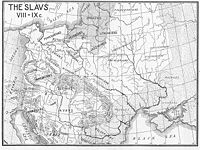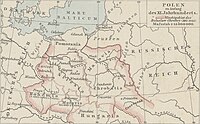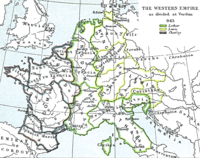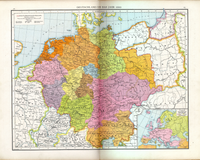White Croatia

White Croatia (also Great Croatia or Chrobatia; Template:Lang-hr, also Velika Hrvatska) is the region from which part of the White Croats supposedly emigrated to the Western Balkans. Some historians believe that, after the migration of the White Croats in the 7th century, their former homeland gradually lost its primacy and was influenced by other Slavic peoples, such as Czechs and Poles. Others say there was never a distinct polity known as White Croatia.[2] According to the medieval Chronicle of the Priest of Duklja, another area referred to as White Croatia was located along with Red Croatia in Dalmatia.[3]
Etymology
The epithets "white" for Croats and their homeland Croatia, as well "great" (megali) for Croatia, is in relation to the symbolism used in ancient times. "White" is related to the use of colors among Eurasian peoples to indicate cardinal directions. White meant "Western Croats/Croatia", in comparison to the lands to the east where they had lived before. The epithet "great" signified "subsequently populated" land, but also "old, ancient, former"[4] homeland for the newly arrived Croats to the Roman province of Dalmatia.[5][6] Historian A. Mayorov emphasizes that the term "White Croats" and the corresponding "White Croatia" are relatively new terms that were applied historically after the Croat migrated to new territories. According to the 10th-century De Administrando Imperio (DAI), Croats who remained living in their former lands near the borders of Francia were only recently been called "White Croats."[7]
Sources
The 10th-century treatise De Administrando Imperio ("On the management of the Empire", later DAI), written in Greek by Constantine VII Porphyrogennetos, is the only known document that suggests "White Croatia" as the place from which Croats migrated to Dalmatia, bordering the coastline of the Adriatic Sea. In Chapter 30, under the heading "The Story of the Province of Dalmatia," it says that "the Croats at that time were dwelling beyond Bagibareia, where the Belocroats are now... The rest of the Croats stayed over near Francia, and are now called the Belocroats, that is, the White Croats, and have their own archon; they are subject to Otto, the great king of Francia, which is also Saxony, and are unbaptized, and intermarry and are friendly with the Turks".
In Chapter 31, "Of the Croats and of the Country They Now Dwell in", it says that Croats in Dalmatia "are descended from the unbaptized Croats, also called the ‘white’, who live beyond Turkey and next to Francia, and they border the Slavs, the unbaptized Serbs... ancient Croatia, also called "white", is still unbaptized to this day, as are also its neighboring Serbs... constantly plundered by the Franks and Turks and Pechenegs... live far away from sea; it takes 30 days of travel from the place where they live to the sea. The sea to which they come down to after 30 days, is that which is called dark".
In Chapter 32, "Of the Serbs and of the Country They Now Dwell in," it was said about the unbaptized ("white") Serbs, that "their neighbor is Francia, as is also Megali Croatia, the unbaptized, also called 'white'".[8]
Croatia Alba, or White Croatia, is referred to in the Latin Chronicle of the Priest of Duklja, compiled no earlier than the 12th century. This work refers to White Croatia as the lower part of Dalmatia (Croatia Alba, que et inferior Dalmatia dicitur), as opposed to Red Croatia, which refers to upper Dalmatia (Croatia Rubea, que et superior Dalmatia dicitur). According to 21st-century historian A. Mayorov, the territory of this Croatia Alba was the most developed and densely populated and formed the core of the emerging Croatian state.[9]
In the undated part of twelfth-century Russian Primary Chronicle, which tells about the resettlement of the Slavs from the Danube, White Croats were mentioned once, together with Sorbs and Chorutans (Carinthians). Czechs immediately associated with the White Croats and the Sorbs. According to A. Mayorov, this account is based on Western European medieval tradition and agrees with the Chronicle of the Priest of Duklja.[10]
Dispute
In 21st-century scholarship, historians do not agree on the location or even the existence of such a White Croatia.[11] According to Majorov, in the 10th century, the ethnic Croats are believed to have been surviving in remnant communities, scattered in the West in Bohemia, with others in the East in Poland, Ukraine, and Slovakia.[12] Given the tradition of using colours for cardinal directions, L. V. Vojtovič argued that the Great Croatia referred to in the 6th century no longer existed in the 10th century. The term White Croatia was used to refer to the Western part of its territory.[13] Scholars such as Vatroslav Jagić have rejected the existence of an independent polity. Similarly, V. V. Sedov noted that there is no archaeological material to prove its existence. Scholars do believe that the Croats gradually moved from the East to the West and South.[14][15]
Interpretations have differed over what geographic area the term Bagibaria refers to. Some scholars have related it to Babia gora near the river Vistula and Krakow in Lesser Poland, but it is more commonly considered to be a reference to Bavaria.[16] Tibor Živković notes that this term can come from the Latin name of Bavaria (Bagoaria or, less probably, Baioaria) and, therefore, the source of this information for the DAI could be of West European origin.[17]
Another dispute is about the geographic reference point of the mentioned "sea to which they come down to after 30 days, is that which is called dark." Some scholars believe this is a reference to the Baltic Sea, to which people could travel in less than 15 days from Lesser Poland.[18] Others say it is the Black Sea, to which travel would take around 30 days from Prykarpattia. The Byzantines knew of the present-day Black Sea very well, but they did not refer to it as "Black" or "Dark", but by a word meaning "Hospitable" (Εὔξεινος). They also used a different term for the word "sea" in its case ("Πόντος" (Póntos) and not "θάλασσα" (Thálassa)).[19]
The DAI has other contradictory information. Although the Croats are described as living near the Franks in the West, they were said to be subject to repeated raids by the Pecheneg, who lived far to the East of this territory. The DAI says that the Pechenegs lived north of the Hungarians, and that the Croats bordered the Hungarians on the south. These chapters are known to have been based on several archival sources. Sedov and Majorov suggest that the DAI mistakenly referred to 7th-century locations and migrations of peoples based on the location of contemporary Croats in Bohemia when the account was compiled.[20][21]
Territory versions
White Croatia was initially thought to have been located along the river Elbe in Bohemia, and around the Vistula River and Lesser Poland.[22] Contemporary Ukrainian and Russian scholars have tended to attribute the Croats with large and influential territories in the East.[23] Pavel Jozef Šafárik (1795–1861) and Lubor Niederle (1865–1944) placed ancient Croatia in Eastern Galicia, and extending west to the Vistula River.[24] N. P. Barsov (1839–1889) situated the Croats in the wide area of Carpathian Mountains, on the slopes of Tatra Mountains to the river Tisza and Prut on the South, to the Dniester to the East, and the Vistula to the North.[24] Some scholars considered that White Croatia took in Nisa and Upper Elbe in the West, to Bug and Upper Prut and Siret in the East.[25] In other words, much of the lands of present-day Czech Republic, Poland and Ukraine.[25]
According to Francis Dvornik, White Croatia extended from the Southern Bug and rivers Wieprz and San along the Poland-Ukraine border, to the slopes of Carpathian Mountains, including the Northern part of Slovakia, then from the rivers Netolica and Dudleba in upper Vltava, through Cidlina to the Krkonoše Mountains to the North and North-West.[22]
Sedov sharply criticized such assumptions: "These hypothetical constructions are now of purely historiographic interest, since they do not find any confirmation in archaeological materials".[26] He believed that the Croats arose among the Antes. After that, they migrated west and settled in several groups in various places.[26] He said that one of these groups were southwestern neighbours of the Dulebes living in the Northern and Southern area of Eastern Prykarpattia. He and B. O. Tymoshchuk said that the Slavic Gords in Bukovina were an offshoot band abandoned by Croats.[24]
O. A Kupchynsʹkyĭ believed that Eastern Croats had territory from Prykarpattia (at the confluence of the rivers Laborec and Ondava at the crest of the Carpathian Mountains), valley of Beskids, western coast of the river Wisłoka, along Sandomierz valley until middle San, near Dunajec and left coast of Vistula. He said they also likely occupied the upper watershed of the Tisza river at the Ukraine-Slovakia border.[27]
In comparison, some scholars placed White Croatia in a smaller territory, roughly from North-Eastern Bohemia to the Upper Vistula valley.[25] This is based on the DAI description that they lived South-East of Bavaria, north of Hungary, and south of the White Serbs.[28] Nada Klaić thought the Croats had migrated from Carantania, rather than from Lesser Poland.[29][30] A. Mayorov distinguishes between the terms and concepts of "White Croatia" and "Great Croatia". He agrees that White Croatia appeared to have some historical presence in the Upper Elbe and Upper Vistula regions, but that Great Croatia (the pre-motherland for the Croats) was located east of the Carpathians (possibly also in Transcarpathia). Mayorov suggests that the author of the DAI made an attempt to reconcile the contradictions among various conflicting sources.[31] Tibor Živković located White Croatia in Bohemia or southern Poland.[32]
See also
Gallery
-
Slavic tribes in 8th–9th centuries;
W. Chrobatians and R. Chrobatians -
Poland under Boleslaw Chrobry
(992–1025) -
Chrobatia to the East of Czechs, edited by J. B. Bury (1903)
-
Belochrobates, by Antoine Philippe Houze (1844)
-
Chrobaci around Cracow, by Karl Spruner von Merz (1855)
-
Chrobatia in 1000, between Cracow and Sandomir, Gustav Droysen (1886)
References
- ^ Božić, Mate (2019). "Hrvat" i "Hrvati" – od toponima do etnonima". Pleter - časopis Udruge studenata povijesti "Toma Arhiđakon". 3 (III): 172. Retrieved 30 November 2019.
- ^ Majorov 2012, p. 21, 52.
- ^ Gluhak 1990, p. 169–185.
- ^ Živković 2012, p. 84–88.
- ^ Gluhak 1990, p. 122–125.
- ^ Hyun Jin Kim (2013). The Huns, Rome and the Birth of Europe. Cambridge University Press. pp. 146, 262. ISBN 9781107009066.
- ^ Majorov 2012, p. 45, 175.
- ^ Živković 2012, p. 49, 54, 83, 88, 111–122, 152.
- ^ Majorov 2012, p. 28–29.
- ^ Majorov 2012, p. 24–28.
- ^ Majorov 2012, p. 58.
- ^ Majorov 2012, p. 58–59.
- ^ Majorov 2012, p. 59.
- ^ Sedov 2013, p. 451.
- ^ Majorov 2012, p. 21.
- ^ Majorov 2012, p. 35, 49, 50–51, 56.
- ^ Živković 2012, p. 112–113.
- ^ Živković 2012, p. 83, 89.
- ^ Majorov 2012, p. 56, 78–79.
- ^ Sedov 2013, p. 450.
- ^ Majorov 2012, p. 48, 54, 58.
- ^ a b Gluhak 1990, p. 125.
- ^ Budak 2018, p. 92.
- ^ a b c Majorov 2012, p. 54.
- ^ a b c Majorov 2012, p. 55.
- ^ a b Sedov 2013, p. 325.
- ^ Korchinsky 2006, p. 38.
- ^ Majorov 2012, p. 50–51, 55.
- ^ Gluhak 1990, p. 128.
- ^ Majorov 2012, p. 57, 63.
- ^ Majorov 2012, Summary.
- ^ Živković 2012, p. 113.
- Sources
- Budak, Neven (2018). Hrvatska povijest od 550. do 1100 [Croatian history from 550 until 1100]. Leykam international. pp. 86–118. ISBN 978-953-340-061-7.
{{cite book}}: Invalid|ref=harv(help) - Gluhak, Alemko (1990), Porijeklo imena Hrvat [Origin of the name Croat] (in Croatian), Zagreb, Čakovec: Alemko Gluhak
- Korchinsky, Orest (2006). "Bijeli Hrvati i problem formiranja države u Prikarpatju" [Eastern Croats and the problem of forming the state in Prykarpattia]. In Nosić, Milan (ed.). Bijeli Hrvati I [White Croats I] (in Croatian). Maveda. ISBN 953-7029-04-2.
{{cite book}}: Invalid|ref=harv(help) - Łowmiański, Henryk (2004) [1963-1985], Nosić, Milan (ed.), Hrvatska pradomovina [Croatian ancient homeland] (in Croatian), Maveda, OCLC 831099194
- Majorov, Aleksandr Vjačeslavovič (2012), Velika Hrvatska: etnogeneza i rana povijest Slavena prikarpatskoga područja [Great Croatia: ethnogenesis and early history of Slavs in the Carpathian area] (in Croatian), Zagreb, Samobor: Brethren of the Croatian Dragon, Meridijani, ISBN 978-953-6928-26-2
- Sedov, Valentin Vasilyevich (2013) [1995]. Славяне в раннем Средневековье [Sloveni u ranom srednjem veku (Slavs in Early Middle Ages)]. Novi Sad: Akademska knjiga. ISBN 978-86-6263-026-1.
{{cite book}}: Invalid|ref=harv(help) - Wojciechowski, Tadeusz (2005) [1873], Nosić, Milan; Pintarić, Neda (eds.), Bijela Hrvatska [White Croatia] (in Croatian), Maveda, ISBN 953-7029-02-6
- Živković, Tibor (2012). De conversione Croatorum et Serborum: A Lost Source. Belgrade: The Institute of History.
{{cite book}}: Invalid|ref=harv(help)
External links
- Croatian Encyclopaedia (2013), Bijela Hrvatska (in Serbo-Croatian)






